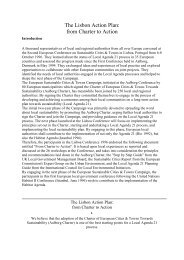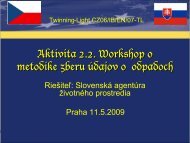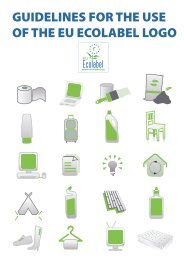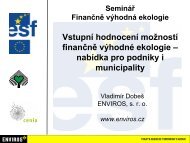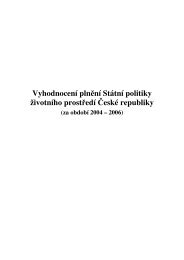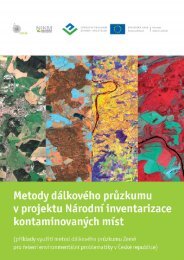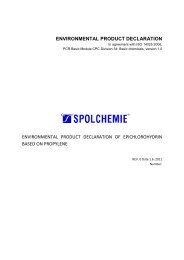Environmental Technologies and Eco-innovation in the Czech ...
Environmental Technologies and Eco-innovation in the Czech ...
Environmental Technologies and Eco-innovation in the Czech ...
Create successful ePaper yourself
Turn your PDF publications into a flip-book with our unique Google optimized e-Paper software.
Because <strong>the</strong> dr<strong>in</strong>k<strong>in</strong>g water shall supply people with necessary nutrients, <strong>the</strong><br />
filtration procedures <strong>and</strong> water distillation are used only for a part of <strong>the</strong> water be<strong>in</strong>g<br />
treated, e.g. for dem<strong>in</strong>eralised water production by MEGA a.s. for <strong>the</strong> boil<strong>in</strong>g plants of<br />
<strong>the</strong> Ostravar <strong>and</strong> Velké Březno breweries.<br />
6.2 | M<strong>in</strong>e water <strong>and</strong> groundwater treatment<br />
Inconsiderate <strong>in</strong>terventions <strong>in</strong> l<strong>and</strong>scape, extensive <strong>in</strong>dustrial production <strong>and</strong> a lack<br />
of environmental education were some of <strong>the</strong> reasons that some types of waste water<br />
were created (mostly <strong>in</strong> <strong>the</strong> old environmental burdens locations). After 1989, several<br />
methods to elim<strong>in</strong>ate pollution from <strong>the</strong>se waste waters were developed, tested <strong>and</strong> <strong>in</strong><br />
<strong>the</strong> end successfully applied <strong>in</strong> <strong>the</strong> <strong>Czech</strong> Republic.<br />
This special type waste water is contam<strong>in</strong>ated groundwater that exists from<br />
production activities at <strong>in</strong>dustrial sites, unsecured l<strong>and</strong>fills <strong>and</strong> <strong>the</strong> water dra<strong>in</strong><strong>in</strong>g<br />
or drawn from former m<strong>in</strong>es. While m<strong>in</strong>e water is usually polluted only with excessive<br />
quantities of dissolved <strong>in</strong>organic salts 3 (without shares of especially dangerous<br />
pollutants), polluted groundwater mostly conta<strong>in</strong>s specific contam<strong>in</strong>ants (heavy<br />
metals, oil products, pesticides <strong>and</strong> herbicides both of organic <strong>and</strong> <strong>in</strong>organic orig<strong>in</strong>).<br />
The specific type of pollution requires specific treatment technologies <strong>and</strong> specific<br />
methods of pollution identification, <strong>the</strong> development of which is tak<strong>in</strong>g place <strong>in</strong><br />
<strong>the</strong> <strong>Czech</strong> Republic at <strong>the</strong> Institute of Chemistry <strong>and</strong> Technology of <strong>Environmental</strong><br />
Protection at Brno University of Technology.<br />
In <strong>the</strong> past, groundwater sanitation occurred ei<strong>the</strong>r <strong>in</strong> situ (at <strong>the</strong> orig<strong>in</strong>al place),<br />
by repeated re-pump<strong>in</strong>g with <strong>the</strong> contam<strong>in</strong>ant’s displacement <strong>and</strong> collection (deaeration<br />
4 ) or as contact filtration 5 connected with <strong>the</strong> regeneration of <strong>the</strong> filtration<br />
material 6 . This is <strong>the</strong> manner by which <strong>the</strong> contam<strong>in</strong>ated groundwater near civil <strong>and</strong><br />
all military airports was cleaned. Today, sanitation of this type of water is carried<br />
out ei<strong>the</strong>r by means of reverse osmosis or us<strong>in</strong>g <strong>the</strong> cleans<strong>in</strong>g effects of <strong>the</strong> grown<br />
microorganism monoculture. The mentioned technologies were patented abroad<br />
but with<strong>in</strong> <strong>the</strong> framework of <strong>in</strong>ternational projects. <strong>Czech</strong> research <strong>in</strong>stitutes also<br />
3 <strong>in</strong>organic salts – substances dissolved <strong>in</strong> water that are of nei<strong>the</strong>r animal nor plant orig<strong>in</strong><br />
4 de-aeration – a procedure where <strong>the</strong> solution is bubbled through with air, <strong>in</strong>to which dissolved gasses gradually pass<br />
5 contact filtration – filtration through material (e.g. activated carbon) that can absorb (b<strong>in</strong>d on <strong>the</strong> surface) some substances<br />
from <strong>the</strong> solution<br />
6 regeneration of <strong>the</strong> filtration material – <strong>the</strong> removal of substances captured on filtration material, e.g. by <strong>the</strong>rmal<br />
process<strong>in</strong>g, which enables its reuse




